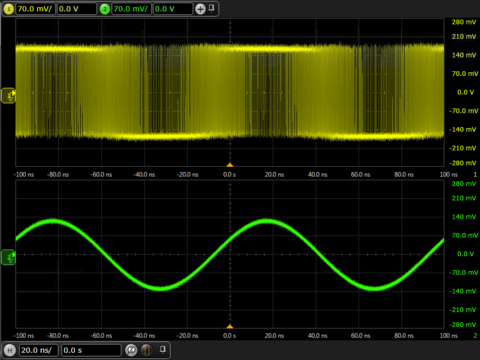Summary
Practically all measurable physical phenomena are eventually transformed into corresponding electrical representations. The transduction of a signal into its electrical counterpart and its subsequent conversion into the digital domain are steps that often include a loss of fidelity. Our goal is to mitigate such effects by developing measurement science innovations in electrical waveform metrology. We accomplish this objective by harnessing the remarkable stability and accuracy of quantum electrical standards, such as the Josephson Arbitrary Waveform Synthesizer (JAWS). Our efforts impact existing ac electrical metrology applications, as well as nascent programs in data converter fidelity, distorted power, impedance comparison, and quantum devices and materials.
Description

Delta--sigma modulation behind the Josephson Arbitrary Waveform Synthesizer (JAWS)
The recent redefinition of the SI was motivated in part by the success of quantum-based electrical standards, such as those based on the Josephson effect. Quantum standards enable the direct realization of physical quantities that are traceable to fundamental constants, invariant with respect to time, and in some cases, readily disseminated. In addition to speeding the metrological shift away from artifacts, quantum standards may usher in new measurement capabilities or profoundly reduce measurement uncertainties.
Fundamental JAWS Metrology
A major priority of our project is the dissemination of the ac quantum volt via the JAWS. The JAWS can synthesize audio waveforms with residual distortion as low as parts in 109, as well as amplitude and phase uncertainties below a part in 106. By digitally controlling the timing and density of input current pulses, arbitrary waveform generation is possible. The quantum accuracy of the JAWS is diminished as the measurement plane moves further from the cryogenic environment of the Josephson junction arrays. Although such limitations arise from purely classical effects, they must be rigorously evaluated in order to minimize uncertainties. To improve practical uncertainties we are developing custom instrumentation and techniques to either mitigate such systematic errors or to accurately quantify them. There are presently three JAWS systems in use within the Applied Electrical Metrology Group: two based on immersion into liquid helium (rms voltages up to 1 V) and one cryocooled system (two channels at 1 V each). We are in the process of building additional immersion probes and another cryocooled JAWS.
Quantum Waveform Applications
Beyond fundamental metrology of the JAWS, we are actively engaged in the development of measurement applications for quantum-based waveforms. We provide support for quantum SI initiatives that rely on waveform synthesis or capture. Some of our current research activities include feasibility studies for high-resolution data converter calibration; harmonic power metrology in support of the SmartGrid; ac impedance comparison bridge metrology to support ac Quantum Hall Resistance (acQHR) research; low-noise transport and calorimetry measurements; and photonic readout schemes for rms detectors.
Major Accomplishments
- Rigorous uncertainty analysis for Army Primary Standards Laboratory
- JAWS load compensation beyond 100 kHz with a negative impedance converter
- JAWS-to-JAWS ac-dc intercomparison
- JAWS-referenced sinusoidal ac power from 40 Hz to 6 kHz.

